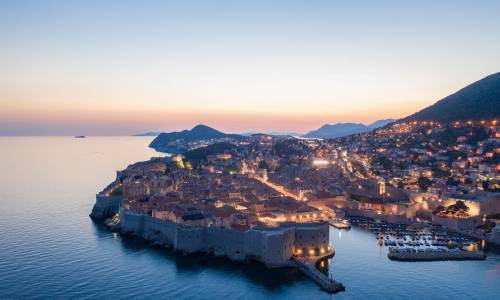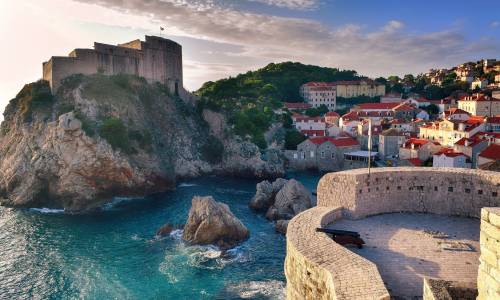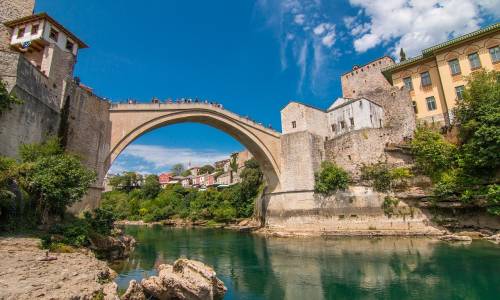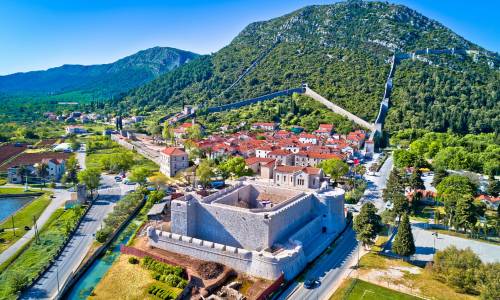Split  Dubrovnik Transfer
Dubrovnik Transfer
INCLUDED IN PRICE
Split to Dubrovnik Transfer, Private Driver & Vehicle
Planning a trip to Croatia and needing a Split to Dubrovnik Transfer?
Look no more, simply book your Split to Dubrovnik Transfer with easy 3 – Step booking and allow our team of professionals to provide you with a smooth experience while in Croatia.
You will be provided with private luxury vehicles and professional English speaking drivers & tour guides.
We recommend earlier start from Split, to avoid potential traffic jams, especially so if you choose to have one of the sightseeing options or wish to experience cuisine & wineries along the way.
There are many sightseeing options when taking a Split to Dubrovnik Transfer, here are 2 of the most popular ones:
Your private driver will be meeting you at the provided address in Split.
If your accommodation is located in strictly pedestrian zone, we will coordinate meeting point with your host or provide you with nearest possible meeting point, same is true for drop-off in Dubrovnik.
We will provide you with your driver’s contact number and vehicle license plates a day before the transfer.
Dubrovnik, The Pearl of the Adriatic


Arriving in Dubrovnik you will be offered by your driver to contact your host in order to arrange a meeting point if your accommodation is located in strictly pedestrian zone and therefore not accessible by car.
Once your driver leaves you off at previously agreed place, your Split to Dubrovnik Transfer is finished.
Enjoy Dubrovnik and the rest of your vacation.
The most popular places to visit while on Split to Dubrovnik Transfer
Turn a regular Split to Dubrovnik Transfer into an amazing experience.
May we suggest that you make it a one way day trip and go from Split to Dubrovnik via Ston (peninsula Pelješac) and taste one of the best oysters in Croatia or visit one of many vineries and enjoy some of the best wines in the Croatian wine empire.
You want to experience a piece of culture of our neighbouring country? Then Split to Dubrovnik with Mostar town is a way to go.
Visit historic town of Mostar in Bosnia & Herzegovina and open air museum that is village of Počitelj.
If you have any questions about any of the transfer options that we offer, or you wish to create your own one way day trip, contact us and we will provide you with the information you need in order to make your stay in Croatia as pleasant as possible.
Tripadvisor Profile
Quality of service is available to you on our Tripadvisor profile.
Read what many satisfied clients have to say about us and our services.
What is Split to Dubrovnik Transfer?
Split to Dubrovnik Transfer is Pre – Booked Private Transfer Service in Croatia offered to our clients.
Starting destination and end destination are previously agreed as well as the pick up time.
Price that is agreed upon is final and there are no additional fees or hidden fees.
For any further information we are at your disposal 24/7.
How to book my Private Transfer Split to Dubrovnik?
For your convinience there is a simple 3 – Step Booking.
After filing up basic transfer / day trip information you will be able to choose payment method.
If you choose to have, any of available activities, contact us for pricing and further information.
What kind of vehicles can I choose from for my Split to Dubrovnik Transfer?
For your Split to Dubrovnik Transfer Service you can choose between Luxury Sedan (up to 3 persons) & Luxury Minivan (up to 7 persons).
The best way of travelling from Split to Dubrovnik?
Easiest way of travelling from Split to Dubrovnik is by using a Private Transfer Service.
Our team of Professional and Knowledgeable Drivers will ensure that you experience your Split to Dubrovnik Transfer in best possible way.
Split or Dubrovnik?
If you are trying to decide whether to visit Split or Dubrovnik during your trip to Croatia, you have work to do for you, but you also cannot make a wrong decision.
Home to a stunning coastline, quaint cobbled streets, delicious food and gorgeous terracotta roofs, there is no doubt that both Dubrovnik and Split are the gems of the Croatian Dalmatian coast, so if you are trying to decide whether to visit Split or Dubrovnik during your travel to Croatia you have a tough decision to make.
Split is Croatia’s second largest city, and Split feels more authentic than its incredibly beautiful but smaller and more touristy brother Dubrovnik.
After the capital Zagreb, the beautiful and historic Split is the second largest city in Croatia and the largest and most important port city on the Dalmatian coast.
From a stopover for tourists traveling by ferry to nearby islands or by private transfer to another more interesting tourist destination, Split has become one of the most popular places to visit in Croatia.
Exploring the Wonders of Split and Dubrovnik: A Journey Through Croatia’s Gems
Croatia, a jewel of the Adriatic Sea, is famed for its stunning coastline, historical landmarks, and vibrant culture. Among its treasures, Split and Dubrovnik stand out as two of the most iconic and alluring destinations.
Both cities boast rich histories, breathtaking scenery, and unique cultural offerings. In this article, we will explore the wonders of Split and Dubrovnik, uncovering why these cities are must-visit destinations for travelers seeking a blend of history, natural beauty, and Mediterranean charm.
Split, The Heart of Dalmatia
A Glimpse into Split’s History
Split, the largest city in Dalmatia, is a fascinating blend of ancient and modern. At its core lies the UNESCO-listed Diocletian’s Palace, a sprawling Roman complex built in the 4th century AD.
The palace’s well-preserved walls, gates, and courtyards offer a window into Roman imperial life and are seamlessly integrated into the city’s modern fabric.
Strolling through the palace’s labyrinthine streets, visitors encounter a mix of bustling cafes, boutique shops, and historical landmarks.
Must-See Attractions in Split
Diocletian’s Palace: The crown jewel of Split, this ancient palace is a maze of ancient ruins and contemporary life. Highlights include the Peristyle Square, the Cathedral of Saint Domnius, and the Temple of Jupiter.
Marjan Hill: Known as the “lungs of Split," Marjan Hill offers panoramic views of the city and surrounding islands. It’s a favorite spot for hiking, jogging, and enjoying nature.
Riva Promenade: This vibrant waterfront promenade is perfect for a leisurely stroll or savoring a coffee while soaking in the lively atmosphere.
Bacvice Beach: A popular sandy beach known for its clear waters and the traditional Croatian game of picigin.
Culinary Delights in Split
Split’s culinary scene is a reflection of its coastal location and Mediterranean heritage. Fresh seafood, olive oil, and locally grown produce take center stage.
Must-try dishes include pasticada (a slow-cooked beef stew) and black risotto made with cuttlefish ink. Pair these meals with a glass of local wine or a refreshing aperitif like Rakija.
Day Trips from Split
Split serves as a gateway to many nearby attractions. A short ferry ride takes travelers to the picturesque islands of Hvar, Brac, and Vis.
The ancient ruins of Salona and the Krka National Park, with its cascading waterfalls, are also within easy reach.
Dubrovnik, The Pearl of the Adriatic
The History of Dubrovnik
Dubrovnik, often referred to as the “Pearl of the Adriatic," is renowned for its well-preserved medieval architecture and stunning city walls. Founded in the 7th century, Dubrovnik grew into a powerful maritime republic, rivaling Venice in trade and culture. Today, the city’s Old Town is a UNESCO World Heritage Site and a testament to its glorious past.
Iconic Landmarks in Dubrovnik
City Walls: Encircling the Old Town, Dubrovnik’s city walls offer a 2-kilometer-long walk with breathtaking views of the Adriatic Sea and the red-roofed cityscape.
Stradun: The main street of Dubrovnik’s Old Town, Stradun is lined with historic buildings, shops, and cafes, making it a lively hub of activity.
Lovrijenac Fortress: Perched on a cliff just outside the city walls, this fortress offers stunning views and insights into Dubrovnik’s defensive history.
Rector’s Palace: Once the seat of Dubrovnik’s government, this elegant palace now houses a museum showcasing the city’s history.
Franciscan Monastery: Home to one of the oldest functioning pharmacies in Europe, this monastery is a treasure trove of historical artifacts and architecture.
Beaches and Outdoor Adventures
Dubrovnik’s crystal-clear waters and rocky beaches are perfect for swimming, snorkeling, and sunbathing. Popular beaches include Banje Beach, located near the Old Town, and Sveti Jakov Beach, a more secluded option. For adventure enthusiasts, sea kayaking around the city walls and the nearby Lokrum Island is a must-try experience.
Game of Thrones Connection
Dubrovnik gained international fame as the filming location for King’s Landing in the hit series Game of Thrones. Fans can explore iconic filming sites, such as the Pile Gate and Fort Lovrijenac, through guided tours that delve into the city’s cinematic history.
Local Cuisine in Dubrovnik
Dubrovnik’s cuisine is deeply rooted in Dalmatian traditions. Fresh seafood, grilled meats, and seasonal vegetables dominate the menu. Don’t miss trying octopus salad, grilled calamari, or the local specialty, rozata, a caramel custard dessert similar to crème brûlée.
Comparing Split and Dubrovnik
While both Split and Dubrovnik are exceptional destinations, they offer distinct experiences. Split’s lively urban vibe, centered around Diocletian’s Palace, contrasts with Dubrovnik’s medieval charm and tranquil Old Town. Split is ideal for those seeking a mix of history and modernity, along with easy access to nearby islands. Dubrovnik, on the other hand, appeals to travelers who appreciate historical architecture, stunning sea views, and cinematic connections.
Practical Tips for Visiting Split and Dubrovnik
Best Time to Visit: The ideal time to visit both cities is during the shoulder seasons of spring (April to June) and fall (September to October) when the weather is pleasant, and the crowds are thinner.
Getting Around: Split and Dubrovnik are best explored on foot, especially their historic centers. For longer distances, public transportation and taxis are readily available.
Currency: Croatia uses the Euro (€). Credit cards are widely accepted, but carrying some cash is advisable for smaller establishments.
Language: Croatian is the official language, but English is widely spoken in tourist areas.
Conclusion
Split and Dubrovnik are two of Croatia’s most enchanting destinations, each offering a unique blend of history, culture, and natural beauty. Whether you’re wandering through the ancient streets of Diocletian’s Palace, marveling at Dubrovnik’s city walls, or indulging in delicious Dalmatian cuisine, these cities promise unforgettable experiences. Plan your trip to Split and Dubrovnik to immerse yourself in the magic of Croatia’s Adriatic coast, where every corner tells a story and every view leaves you in awe.



